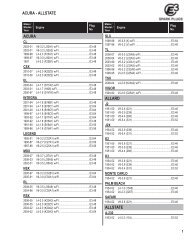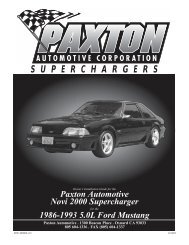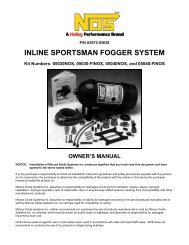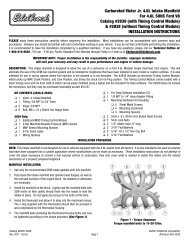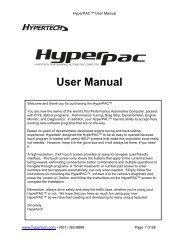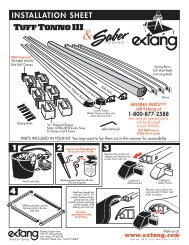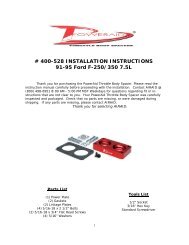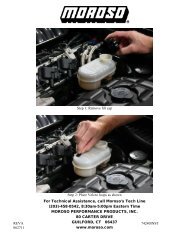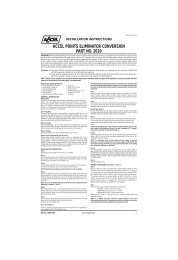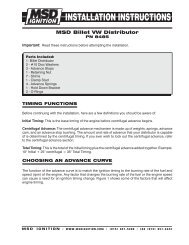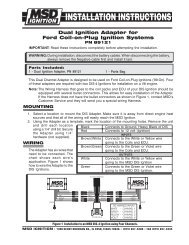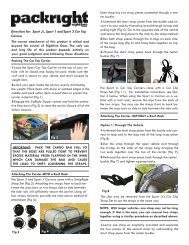Edelbrock 70055 Nitrous System Installation Instructions - Jegs
Edelbrock 70055 Nitrous System Installation Instructions - Jegs
Edelbrock 70055 Nitrous System Installation Instructions - Jegs
You also want an ePaper? Increase the reach of your titles
YUMPU automatically turns print PDFs into web optimized ePapers that Google loves.
4.0 Baseline Tuning Suggestions<br />
Utilizing nitrous oxide as a power adder is similar to a supercharger or a turbocharger in that it increases the<br />
amount of air an engine can get from atmospheric conditions. There are some significant differences though:<br />
1. The “air” in nitrous oxide is very oxygen rich. This oxygen is of a much higher density, so the opportunity to<br />
extract very high quotients of power is very high.<br />
2. <strong>Nitrous</strong> oxide injection does not have a parasitic load factor associated with its use like a turbocharger or<br />
supercharger does. Meaning, it does not cost as much horsepower as a crank-driven supercharger or an<br />
exhaust-driven turbocharger.<br />
The most important thing to remember when looking at baseline tuning issues associated with nitrous oxide is that<br />
a nitrous “rich” condition is bad. Two parameters that will keep you from catastrophically affecting your engine are:<br />
<strong>Nitrous</strong> Bottle Pressure...Always keep your bottle pressure between 900 and 950 psi. Yes, there are racers<br />
that use different pressures, but the testing we did here at <strong>Edelbrock</strong> to ensure the jetting maps within the<br />
manual are correct, was done in this pressure range. Use any higher pressure than 950 psi and you will be<br />
nitrous “rich”. Use any pressure below 900 psi and you will be nitrous “lean”.<br />
Fuel Pressure...Always ensure that you have between 7 and 7.5 psi of fuel pressure every time you enable<br />
your nitrous system. We used 7 to 7.5 psi of fuel pressure to perform our jetting map testing on this system.<br />
If you do not have at least 7 psi of fuel pressure going to the fuel solenoid, when it is activated, you will be<br />
nitrous “rich”. If you were to have more than 7.5 psi of fuel pressure going to the fuel solenoid you will be<br />
nitrous “lean”.<br />
The jet map provided for your Performer RPM nitrous system is purposefully “rich”, or biased to the fuel side of the<br />
nitrous to fuel ratio. There are many different ways to jet to a specific power level. However, for the continued safe<br />
operation of your nitrous system, we suggest you do not move too far away from the jet map listed within this<br />
manual. Catastrophic engine failure could result.<br />
Your Performer RPM nitrous system comes with matched sets of nitrous and fuel jets. These are conservative<br />
jetting combinations, based upon 900 to 950 psi nitrous oxide bottle pressure, and 7 to 7.5 psi flowing fuel<br />
pressure. Operating with these pressure levels should yield safe and reliable power increases.<br />
How to Read Spark Plugs From a <strong>Nitrous</strong> Oxide Injected Engine...<br />
Spark plugs are a window into the combustion chamber. They will tell many things about the operation of the vehicle. Here<br />
are some tips on looking at spark plugs to “read” what is happening with your engine:<br />
1. Correct timing, mixture and spark heat range<br />
Ground strap retains “like new” appearance. Edges are crisp, with no signs of discoloration. Porcelain retains<br />
clear white appearance with no “peppering” or spotting.<br />
2. Excessively rich mixture<br />
Porcelain may be fuel stained, appearing brown or black. In extreme cases, ground strap, electrode and<br />
porcelain may be damp with gasoline, or smell of fuel.<br />
3. Detonation<br />
Edges of ground strap may be rounded. Porcelain has the appearance of being sprinkled with pepper, or may<br />
have aluminum speckles. During heavy detonation, the ground strap tip may burn off. This phenomena can<br />
result from excessive ignition timing, too high a heat range spark plug or inadequate fuel octane.<br />
4. Excessive lean mixture<br />
Edges of ground strap may become rounded. Under moderate overheating the tip of the ground strap can<br />
discolor, usually turning purple, or the entire ground strap can become discolored.<br />
Catalog #<strong>70055</strong> & #70056<br />
Brochure No. 63-0060<br />
Page 21 of 26<br />
©2002 <strong>Edelbrock</strong> Corporation<br />
Rev. 3/02



